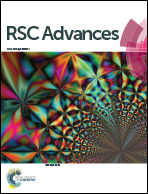Biomolecule incorporated poly-ε-caprolactone nanofibrous scaffolds for enhanced human meniscal cell attachment and proliferation†
Abstract
The present study investigates the impact of biomolecule (biotin and galactose) incorporated poly-ε-caprolactone (PCL) nanofibrous scaffolds on attachment and proliferation of human meniscal cells by three modes of biomolecule supplementation. Two different ratios of biomolecules like biotin and galactose were incorporated in nanofibers using a standardized electrospinning process. Surface morphologies of control and biomolecule incorporated nanofibers were analyzed by field emission scanning electron microscope (FESEM). The presence of the biomolecules in the nanofibers was confirmed by Fourier Transform Infrared (FTIR) Spectroscopy. The biodegradability of pure PCL and biomolecules incorporated nanofibers was determined. The biomolecule embedded inside PCL nanofibrous scaffolds were studied in terms of DNA content and extra cellular matrix (ECM) (glycosaminoglycans (GAG) and collagen) for meniscus cell attachment, growth and proliferation with and without addition of these biomolecules (in the scaffold and in the medium). FESEM and fluorescence microscopic studies were used to confirm cell proliferation on the surface of the scaffolds. In vitro human meniscal cell culture study revealed that galactose incorporation was more efficient when compared to biotin. Enhanced meniscal cell attachment and proliferation were achieved when half of the biomolecule was inside the nanofiber and the other half was in the medium. This approach to improve the cell attachment onto the scaffold is a promising strategy for meniscal tissue engineering.


 Please wait while we load your content...
Please wait while we load your content...